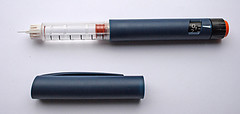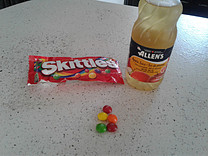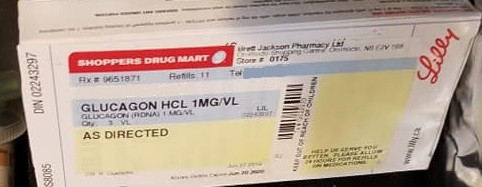What does Glucagon does became important to understand when our young grandson was diagnosed with type 1 diabetes. There was so much to learn and at times it felt overwhelming.
I spent a lot of time researching online for anything and everything I could find about type 1 diabetes and our daughter was teaching us all of the things she was learning from Alex’s diabetes care team.
Here we are 21 months into our type 1 journey and while we are still learning every day, we are so much more confident and comfortable with all the various aspects of diabetes treatment and management.
So comfortable in fact, that we are having another sleepover with Alex and his sisters this weekend so his parents can get away for uninterrupted time alone together.
This means that I will be Alex’s main caregiver during the time his parents are away. Of course, I won’t be totally on my own. Both Alex’s sisters know how to care for his diabetes and at 16 and 13 are very proficient at it.
If we manage his diabetes properly, we should not need to administer Glucagon but it is something we need a working knowledge of.
Table of Contents
The insulin, glucagon and blood sugar connection
 Insulin and glucagon are both hormones that work together to help regulate the blood glucose (sugar) levels in your body. Glucose comes from the food you eat and moves through your bloodstream to help fuel your body.
Insulin and glucagon are both hormones that work together to help regulate the blood glucose (sugar) levels in your body. Glucose comes from the food you eat and moves through your bloodstream to help fuel your body.
Insulin and glucagon are made by your body and work together for optimal blood glucose management.
So what does each of these hormones do?
How insulin works
During the digestion process, the carbohydrates we have eaten are converted into glucose. Most of this glucose is sent into your bloodstream, causing a rise in blood glucose levels.
This increase in blood glucose signals your pancreas to produce insulin.
Insulin gives glucose access to the cells by attaching to the insulin receptors on cells throughout the body, instructing the cell to open up and allow the glucose to enter.
As the glucose moves into your cells your blood glucose levels go back down.
There are low levels of insulin constantly circulating throughout the body.
When insulin levels spike that signals to the liver that blood glucose is also high. The liver then absorbs this glucose and converts it into a storage molecule called glycogen.
When blood sugar levels drop, glucagon instructs the liver to convert the glycogen back to glucose, causing blood sugars to rise to normal.
Insulin also helps you to heal after an injury by delivering amino acids to the muscles. Amino acids help build the protein in muscle tissue. This is why when insulin levels are low, muscles may not heal properly.
Any unused glycogen will be converted and stored as fat.
How Glucagon works
Glucagon will counterbalance the insulin.
Four to six hours after eating, your blood glucose levels decrease. This triggers your pancreas to produce glucagon.
The presence of glucagon will tell your liver and muscles to change the stored glycogen back into glucose. These cells will then release the glucose back into your bloodstream so your other cells can use it for energy.
It is quite the efficient loop with insulin and glucagon in a state of constant motion keeping your blood glucose levels balanced and all your cells receiving the fuel they need to function properly.
How insulin and glucagon work together
It is fascinating how insulin and glucagon work in something called a negative feedback loop.
This means that one event triggers another, which triggers another.
This cycle continues on and on maintaining balanced blood sugar levels.
You eat which makes your blood sugars rise which triggers your body to make insulin, insulin provides your cells with fuel and triggers your liver ad muscles to store glycogen, blood sugars drop which signals your body to make glucagon which signals your liver and muscles to convert that glycogen back into glucose which then makes blood sugars rise.
At some point, you are hungry again and of course, this cycle is repeated endlessly.
Glucagon and diabetes
Type 1 diabetes
Of the most commonly known types of diabetes, type 1 is the least common form.
Type 1 diabetes is an autoimmune disorder in which the body’s immune system attacks and kills the insulin-producing beta cells within the pancreas.
This means that the body can no longer produce insulin causing blood sugar levels to rise dangerously high risking many diabetes complications including diabetic ketoacidosis which is a life-threatening emergency.
A type 1 diabetic will need to take insulin either by injection or pump every day for the rest of their life. Without taking insulin they will die in a relatively short period of time.
Type 2 diabetes
In type 2 diabetes, your body makes insulin but your cells are unable to respond to it properly.
Your cells no longer take in the glucose from your bloodstream as well as they once did, leading to higher than normal blood glucose levels.
Over time your body may produce less insulin which can then further raise your blood glucose levels.
Type 2 diabetics are often prescribed oral medications to help them use insulin more efficiently.
Gestational diabetes
Gestational diabetes develops in late pregnancy for some women.
For some reason, pregnancy hormones can interfere with how insulin works in the body.
Gestational diabetes usually disappears postpartum.
It is important to note that women who have experienced gestational diabetes are at a greater risk of developing type 2 diabetes in the future.
Prediabetes
When someone has prediabetes, their body makes insulin but doesn’t use it properly. This causes elevated blood glucose levels although not as high as someone with type 2 diabetes.
Many people diagnosed with prediabetes will go on to develop type 2 diabetes unless they make the necessary lifestyle changes.
Glucagon and blood sugar levels
It takes time for the body to receive the signals to either produce or stop producing glucagon particularly in someone whose blood sugar levels are extremely high or dangerously low.
Sometimes in diabetics, the presence of glucagon can raise blood glucose levels too high.
This is either the result of not enough insulin or as in type 2 diabetes, the body does not properly respond to insulin.
Another problem that can affect type 1 diabetics is that high levels of circulating insulin can inhibit the release of glucagon in response to hypoglycemia, which can also be very dangerous.
High blood sugars
The symptoms of high blood sugar (hyperglycemia) may include:
- increased urination, this is in response to the kidneys effort s of eliminating excess glucose
- excessive thirst often accompanies the increased urination, as the kidneys try to flush out the excess sugar you may experience dehydration
- feeling excessively hungry, while high blood sugar doesn’t cause hunger, a drop in insulin may cause hunger when accompanied by high blood sugar
- diabetic ketoacidosis (DKA) a very serious, life-threatening complication of type 1 diabetes
If left untreated, extremely high blood sugars may lead to:
- unexplained weight loss
- slow healing
- dry, itchy skin
- increased risk of infections
- headaches
- fatigue or inability to concentrate
- blurred vision
- constipation, diarrhea, or both
- erectile dysfunction
Diabetics frequently check their blood glucose levels and can treat a low before it becomes severe.
Low blood sugars
Having meals late, poor nutrition, some diabetes medications and certain medical conditions can cause low blood sugar (hypoglycemia) and symptoms can include:
- dizziness
- rapid heartbeat
- weakness
- tingling in the tongue, lips, arms or legs
- hunger alongside nausea
- fainting
- confusion and difficulty concentrating
- irritability
If treatment is not obtained, low blood sugar can lead to seizures, loss of consciousness or death.
When our grandson is here we usually give him a fast-acting sugar snack when his blood sugars are too low. With Alex 1/4 cup of apple juice or 5 skittles is usually all he needs to start rising his blood sugars closer to the target range.
Medications that can affect glucagon secretion
There are a number of medications that can help modify the release of glucagon in type 2 diabetes.
The two different classes of diabetes drugs would be DPP-4 inhibitors and incretin mimetics.
These drugs act in response to the presence of meals to stimulate the increase of insulin and to inhibit the release of glucagon.
Glucagon injections
A glucagon emergency kit is often part of the treatment plan of type 1 diabetics.
Glucagon can be administered by injection or inhaled nasally ( a recently approved new method) in response to severe episodes of hypoglycemia (low blood sugars).
Glucagon is a very useful part of the treatment plan for diabetics treating their diabetes with insulin.
Final thoughts
What does glucagon do?
Amazingly it is much more important than I previously realized.
Glucagon works together with insulin in what is known as a negative feedback loop to maintain a very narrow margin of blood sugar control.
When we eat our blood sugars rise which stimulates the production of insulin so our cells can receive the fuel they need. This lowers blood sugar levels. If those levels drop too low or there is too much insulin circulating the body is signalled to release glucagon to raise those blood sugar levels.
Diabetics are either not producing insulin (type 1) or not using insulin effectively (type 2) which causes blood sugar levels to rise too high causing hyperglycemia.
Not eating meals on time, exercise or taking too much insulin can cause blood sugar levels to drop too low causing hypoglycemia which will require treatment with glucagon.
Glucagon can be injected or taken nasally to treat severe hypoglycemia.
Your health care team will help you develop an emergency plan for you in case you experience severe hypo events.
Do you have your emergency care plan in place?
Have the people you work with or are around each day been trained on how to administer glucagon in an emergency?
What have your experiences with glucagon been?
Leave your answers in the comment section below and check out savings on diabetes supplies below.


I could share my take on this saying Glucagon’s role in the body is to prevent blood glucose levels from dropping too low.
So, in order to do this, it acts on the liver in several ways. One of the ones that impressed me the most is that it stimulates the conversion of stored glycogen (stored in the liver) to glucose, which can be released into the bloodstream. This process is called glycogenolysis.
Thank you for taking the time to comment.
Yes as you said glucagon’s role is to prevent blood glucose from dropping too low.
For type 1 diabetics in particular the system doesn’t work as it should.
What I mean is :
When we eat our blood sugar rises, signalling our pancreas to produce insulin.
This insulin is what allows the glucose from our food to enter the cells as fuel, and to store some in the liver and muscles as glycogen, this then causes the blood sugar levels to drop.
The drop in blood sugars tells our liver and muscles to convert that glycogen back into glucose to feed our cells.
The problem is that a type 1 diabetic does not produce insulin and therefore blood sugars remain too high until it has been eliminated from the body. Extreme thirst leading to frequent urination as the body tries to flush out the excess sugars.
Long periods of time without eating, or intense exercise can cause blood sugars to lower, in type 1 those sugars fluctuate beyond normal levels and they can be dangerously low in no time risking unconsciousness or death.
This is why it is so important for type 1 diabetics to frequently check their blood sugar levels and take insulin several times daily.
Our grandson takes 4 insulin injections daily as a minimum and his lows are treated with fast-acting sugars snacks (apple juice works well). If he were to go so low that he couldn’t swallow we (his caregivers) would inject glucagon as a life-saving measure before taking him to the hospital.
Thanks so much for the comment.
We are use to diabetes type 2 which occurs in adult. It is not common amidst children. I like the way you balanced the understanding of the various types of diabetes and how the bady react and the pancreas functions to balance the supply of insulin to the body system. Although diabetes is an illness but it is not a death sentence. It can be managed in adult. Children and even pregnant women
Thanks for taking the time to comment.
Yes, type 2 diabetes is not common in children, however, the incidence of it occurring in children is rising in North America which I find alarming.
You are also correct that diabetes in any form can be treated and those affected can lead very normal productive lives. We witness this every day with our grandson.
Being diligent about checking blood glucose levels and treating highs and lows promptly is key to avoiding many diabetes-related complications.
The key to managing diabetes is in following the diabetes care plan set by your diabetes care team regardless of which type or the age of the diabetic.
Thanks again and take care.